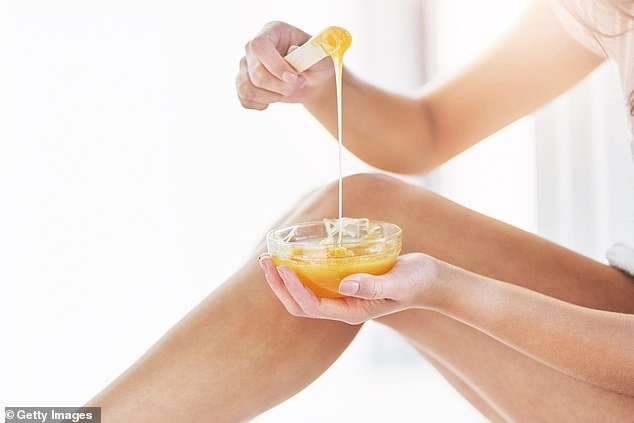With uncertainty over when salons will re-open many of us are desperate to recreate professional treatments at home – including DIY alternatives to waxing.
Sugaring is the latest beauty trend to sweep social media, a natural alternative to waxing which involves making your own hair removal mixture by boiling sugar, lemon juice and water.
The method is popular because it’s all-natural, and therefore kinder to sensitive skin that wax strips or hair removal cream, as well as being cost effective, and because it works on shorter hairs than waxing it leaves skin smoother for longer.
However, if done incorrectly the technique can have severe consequences, including burns, infections and irreversible scarring.
Intimate health expert Stephanie Taylor warned that using the mixture on intimate areas can lead to ‘severe scolding’ if temperatures are too hot, and that the recipe is very similar to napalm, homemade substance often used as a weapon by prisoners.
Meanwhile, dermatologist Dr Shirin Lakhani told that while she there are advantages to natural ingredients, DIY methods are easy to get wrong, and that there’s a ‘level of technique’ when it comes to removing the paste that is difficult to apply at home.
Intimate health expert Stephanie Taylor and Dr Shirin Lakhani warned against a viral trend to remove body hair. Stock image
RISK OF BURNS
Stephanie said: ‘Sugaring can cause severe scalding to the sensitive skin in your intimate area if the temperature of the water is too hot when applied. This can leave you with painful burns, dangerous infections and irreversible scarring.
‘Very worryingly, the recipe is very similar to a homemade substance often used by prison inmates as a weapon, known colloquially as napalm. The mixture sticks to the skin and intensifies burns, leaving people with horrific injuries.
‘The real trouble with the DIY waxing techniques we’re seeing circulate online is there are no safety guidelines or guarantees, and it can be guesswork when it comes to cooling down the temperature of the sugar solution. Getting the temperature just right is a vital step in ensuring your safety and that it removes hair successfully.
‘Sugar is a ‘non-volatile solute’, meaning it raises the boiling point of water. In other words, this mixture will be incredibly hot while it’s being made. If it splashes or is used before it’s cooled down enough it could inflict some serious pain and injury.
‘This lockdown, I’d recommend leaving intimate waxing to the experts or buying an at-home kit from a recognised brand which come with tried and tested instructions to keep you safe.’
She added that if you have experienced burns, treat them with cold water immediately.
‘If you do burn the skin, it’s important to treat it with cold water immediately for a minimum of 20 minutes. Don’t apply ice (this can also burn the skin) or use any oil-based products on the skin.’
RISK OF BRUISING
Dr Amelie Seghers, Consultant Dermatologist at the Cadogan Clinic, agreed that the method can lead to both bruising or burning if not properly carried out.
She said: ‘There is also a risk of bruising – there is a special technique to removing the sugar paste – if the skin is not held tightly or if the paste is removed incorrectly, it could result in bruising. If the paste is left on for too long there is also risk of the hair follicles becoming inflamed or infected (folliculitis).’
Dr Lakhani added: ‘There is also a level of technique when it comes to removing the paste. If this is done incorrectly you may experience bruising and bleeding.’
FUNGAL INFECTIONS
Dr Lakhani aksi revealed there’s no way to know how your skin will react to the method, and could lead to ‘trauma to the skin’ or fungal infections.
‘Microorganisms on the skin need food, moisture and heat to grow, and while sugaring can help with ingrown hairs in some people, it can make folliculitis worse in others.
‘We’re generally looking to remove hair where our skin is most sensitive including our intimate parts where the skin is particularly delicate.
‘Not only could you cause injury and trauma to the skin but using the wrong products can cause an imbalance of the pH and lead to fungal infections such as thrush.’
NOT SAFE IF YOU’RE ON MEDICATION
Both Dr Lakhani and Dr Seghers warned that treatments such as sugaring should be avoided if you are taking steroids or oral Isotretinoin, known as Roaccutane or Accutane.
‘You should be very careful about trying treatments like this if you’re currently taking steroids or Roaccutane, you have bruising, swelling, rashes, open sores or even sunburn and cold sores’, said Dr Lakhani.
Dr Seghers added: ‘Sugaring should be avoided on skin where products such as retinol are used which may make the skin more sensitive and also on skin where there is bruising, broken skin, or sunburn and for people taking steroids or oral Isotretinoin.
